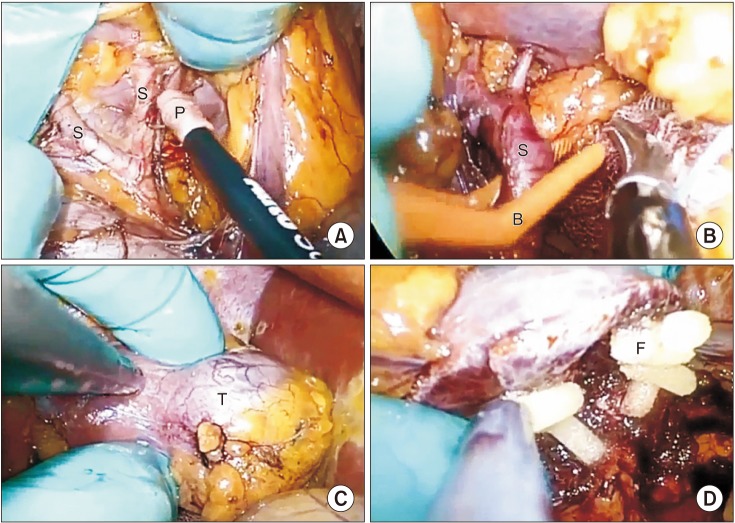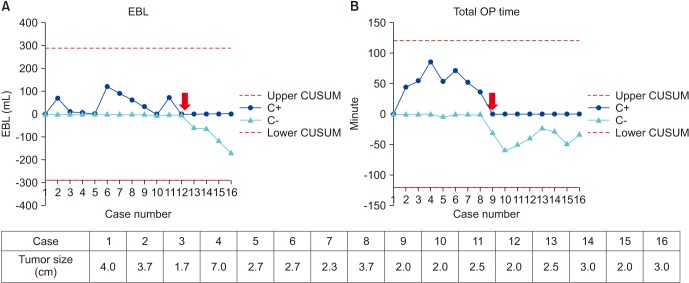Investig Clin Urol.
2019 Mar;60(2):99-107. 10.4111/icu.2019.60.2.99.
Selective clamping hand-assisted laparoscopic partial nephrectomy for localized renal tumors: A novel technique
- Affiliations
-
- 1Department of Urology, Korea University Ansan Hospital, Korea University College of Medicine, Ansan, Korea. jaeyoungpark@korea.ac.kr
- KMID: 2438820
- DOI: http://doi.org/10.4111/icu.2019.60.2.99
Abstract
- PURPOSE
In this study, we described our initial experience and analyze the learning curve of segmental renal artery branch clamping with hand-assisted laparoscopic partial nephrectomy (PN) using special instruments.
MATERIALS AND METHODS
We conducted a retrospective review of consecutive cases of hand-assisted laparoscopic PN (LPN) between May 2015 and April 2018. Patient demographics, tumor characteristics, perioperative details, postoperative complications, and warm ischemic time for segmental artery branch clamping were included in our analysis. We used the cumulative sum (CUSUM) method to generate learning curves.
RESULTS
Segmental renal artery branch clamping was successfully completed in 16 of 20 patients. The median tumor size was 2.9 cm (range, 1.7-7.0 cm), median operation time was 185 minutes (range, 140-245 minutes), median blood loss was 291 mL (range, 100-600 mL), and median hospital stay was 5 days (range, 4-7 days). The median selective ischemic time was 21 minutes (range, 16-35 minutes). No patient had postoperative complications, acute or delayed bleeding. The median pre- and postoperative serum creatinine levels (0.91 and 0.98 mg/dL, respectively), and the pre- and postoperative estimated glomerular filtration rate (89.7 and 79.6 mL/min per 1.73 m2, respectively) were similar. Upon visual assessment of the CUSUM plots, a downward inflection point for decreasing total operation time was observed in the 9th case and estimated blood loss in the 12th case.
CONCLUSIONS
Our study shows that segmental renal artery branch clamping hand-assisted LPN for localized renal tumors is feasible, safe, and has a relatively short learning curve.
Keyword
MeSH Terms
Figure
Reference
-
1. Motzer RJ, Jonasch E, Agarwal N, Beard C, Bhayani S, Bolger GB, et al. Kidney cancer, version 3.2015. J Natl Compr Canc Netw. 2015; 13:151–159. PMID: 25691606.
Article2. Herr HW. Partial nephrectomy for unilateral renal carcinoma and a normal contralateral kidney: 10-year followup. J Urol. 1999; 161:33–34. discussion 34-5. PMID: 10037361.
Article3. Gill IS, Desai MM, Kaouk JH, Meraney AM, Murphy DP, Sung GT, et al. Laparoscopic partial nephrectomy for renal tumor: duplicating open surgical techniques. J Urol. 2002; 167:469–467. discussion 475-6. PMID: 11792899.
Article4. Lane BR, Campbell SC, Gill IS. 10-year oncologic outcomes after laparoscopic and open partial nephrectomy. J Urol. 2013; 190:44–49. PMID: 23306087.
Article5. Choi JD, Park JW, Lee SY, Jeong BC, Jeon SS, Lee HM, et al. Does prolonged warm ischemia after partial nephrectomy under pneumoperitoneum cause irreversible damage to the affected kidney? J Urol. 2012; 187:802–806. PMID: 22245321.
Article6. Porpiglia F, Bertolo R, Amparore D, Fiori C. Margins, ischaemia and complications rate after laparoscopic partial nephrectomy: impact of learning curve and tumour anatomical characteristics. BJU Int. 2013; 112:1125–1132. PMID: 23937616.
Article7. Andrade HS, Zargar H, Caputo PA, Akca O, Kara O, Ramirez D, et al. Five-year oncologic outcomes after transperitoneal robotic partial nephrectomy for renal cell carcinoma. Eur Urol. 2016; 69:1149–1154. PMID: 26719014.
Article8. Li X, Huang Y, Liu W, Li P, Tang L, Xu Y, et al. A model for assuring clamping success during laparoscopic partial nephrectomy with segmental renal artery clamping. World J Urol. 2016; 34:1421–1427. PMID: 26879417.
Article9. Shao P, Qin C, Yin C, Meng X, Ju X, Li J, et al. Laparoscopic partial nephrectomy with segmental renal artery clamping: technique and clinical outcomes. Eur Urol. 2011; 59:849–855. PMID: 21146917.
Article10. Gill IS, Patil MB, Abreu AL, Ng C, Cai J, Berger A, et al. Zero ischemia anatomical partial nephrectomy: a novel approach. J Urol. 2012; 187:807–814. PMID: 22248519.
Article11. Cundy TP, Gattas NE, White AD, Najmaldin AS. Learning curve evaluation using cumulative summation analysis-a clinical example of pediatric robot-assisted laparoscopic pyeloplasty. J Pediatr Surg. 2015; 50:1368–1373. PMID: 25783405.
Article12. Gill IS, Eisenberg MS, Aron M, Berger A, Ukimura O, Patil MB, et al. "Zero ischemia" partial nephrectomy: novel laparoscopic and robotic technique. Eur Urol. 2011; 59:128–134. PMID: 20971550.
Article13. Satkunasivam R, Tsai S, Syan S, Bernhard JC, de Castro Abreu AL, Chopra S, et al. Robotic unclamped "minimal-margin" partial nephrectomy: ongoing refinement of the anatomic zero-ischemia concept. Eur Urol. 2015; 68:705–712. PMID: 26071789.
Article14. Furukawa J, Miyake H, Hinata N, Muramaki M, Tanaka K, Fujisawa M. Renal functional and perioperative outcomes of selective versus complete renal arterial clamping during robotassisted partial nephrectomy: early single-center experience with 39 cases. Surg Innov. 2016; 23:242–248. PMID: 26459499.15. Martin GL, Warner JN, Nateras RN, Andrews PE, Humphreys MR, Castle EP. Comparison of total, selective, and nonarterial clamping techniques during laparoscopic and robot-assisted partial nephrectomy. J Endourol. 2012; 26:152–156. PMID: 22192110.
Article16. Simone G, Gill IS, Mottrie A, Kutikov A, Patard JJ, Alcaraz A, et al. Indications, techniques, outcomes, and limitations for minimally ischemic and off-clamp partial nephrectomy: a systematic review of the literature. Eur Urol. 2015; 68:632–640. PMID: 25922273.
Article17. Simone G, Papalia R, Guaglianone S, Carpanese L, Gallucci M. Zero ischemia laparoscopic partial nephrectomy after superselective transarterial tumor embolization for tumors with moderate nephrometry score: long-term results of a single-center experience. J Endourol. 2011; 25:1443–1446. PMID: 21797763.
Article18. Aboumarzouk OM, Stein RJ, Eyraud R, Haber GP, Chlosta PL, Somani BK, et al. Robotic versus laparoscopic partial nephrectomy: a systematic review and meta-analysis. Eur Urol. 2012; 62:1023–1033. PMID: 22771266.
Article19. Azawi NH, Norus TP, Wittendorff HE, Dahl C. Hand-assisted partial nephrectomy with early arterial clamp removal: Impact of the learning curve. Scand J Urol. 2014; 48:538–543. PMID: 24930565.
Article20. Han KS, Song GH, You D, Song C, Jeong IG, Hong JH, et al. Comparison of hand-assisted laparoscopic vs robot-assisted laparoscopic vs open partial nephrectomy in patients with T1 renal masses. J Endourol. 2017; 31:374–379. PMID: 25353326.
Article21. Greene RN Jr, Sutherland DE, Tausch TJ, Perez DS. Retrograde renal hilar dissection and segmental arterial clamping: a simple modification to achieve super-selective robotic partial nephrectomy. J Robot Surg. 2014; 8:19–22. PMID: 27637234.
Article
- Full Text Links
- Actions
-
Cited
- CITED
-
- Close
- Share
- Similar articles
-
- Laparoscopic Partial Nephrectomy without Renal Arterial Clamping
- Laparoscopic Partial Nephrectomy using a Microwave Tissue Coagulator for Small Renal Tumor
- Percutaneous Embolization of Renal Artery Pseudoaneurysm after Laparoscopic Partial Nephrectomy for Renal Cell Carcinoma
- Non-ischemic Partial Nephrectomy with Using the Microwave Tissue Coagulator
- Hand-Assisted Laparoscopic Nephrectomy and Auto-Transplantation for a Hilar Renal Artery Aneurysm: A Case Report




